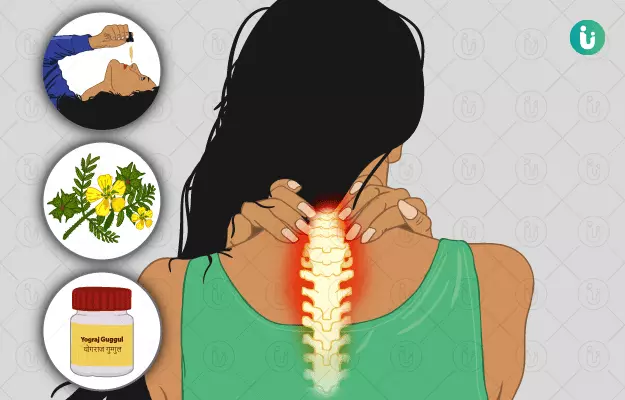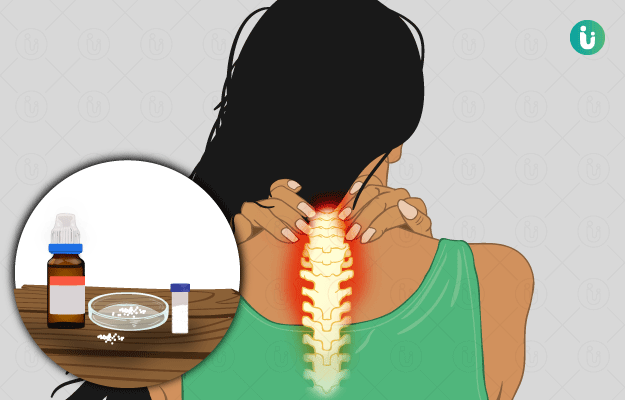Cervical pain, also called manya shula in Ayurveda, refers to stiffness and pain in the cervical region of the neck and back. This can be caused by conditions such as ankylosing spondylitis, cervical spondylosis, rheumatoid arthritis and prolapsed disc.
Ayurveda describes numerous treatments for the management of cervical pain. These include abhyanga (oil massage), ruksha swedana (dry sudation or sweat therapy), manya basti (an external basti in which medicated oil is pooled over the neck), nasya (nasal insufflation) and lepa (coating the affected body part with medications). Herbs such as rasonam (garlic) and gokshura (small caltrops) have been used in the management of cervical pain. Medicines that are used in the treatment of cervical pain are dashmoola kwatha, prasarini taila, yogaraja guggulu and laksha guggulu among others.
- Ayurvedic view of cervical pain
- Ayurvedic treatment for cervical pain
- Ayurvedic herbs and medicines for cervical pain
- Dietary and lifestyle changes for cervical pain patient as per ayurveda
- How effective are ayurvedic medicines and treatments for cervical pain
- Side effects and risks of ayurvedic medicine and treatments for cervical pain
- Takeaway
Ayurvedic view of cervical pain
Ayurveda describes various conditions that may lead to pain in the cervical region by creating an imbalance in doshas. These include:
- Manya stambha (cervical spondylosis): It is the most common cause of cervical pain, which causes vitiation of vata, leading to rigidity and stiffness of the muscles of neck and, thus, pain in the cervical region.
- Ankylosing spondylitis: It is a systemic, chronic inflammatory condition affecting the spine. It causes pain in the back including the cervical region. It occurs due to the vitiation of vata dosha and affects bones and bone marrow.
- Slipped disc: In this condition, the cartilaginous disc between the spinal vertebrae, which acts as a shock absorber, slips out of place. It may occur due to injury, lifting weights, etc. and can lead to pain and pinching of the nearby nerves. It is most commonly seen in the lower back, but can also affect the cervical region.
- Rheumatoid arthritis: It is an autoimmune disease causing chronic inflammation and pain in the affected joints. This disease leads to aggravation of vata and accumulation of ama (toxins) in joints. Rheumatoid arthritis causes cervical pain when it affects the cervical region.
- Osteoarthritis: It is characterised by pain, swelling and stiffness of the joints due to the aggravation of the vata dosha. Osteoarthritis causes cervical pain when the aggrevated vata dosha affects the cervical region.
Ayurvedic treatment for cervical pain
- Abhyanga
- It is a massage therapy that involves the application of pressure to specific points in the body, which helps in relieving pain and other associated symptoms.
- This massage primarily helps by transferring nutrients and eliminating toxins from body cells. It is effective in removing fatigue and stress, improving vision, promoting sturdiness and strengthening the nervous system. Abhyanga also promotes the production of antibodies, which fight against various pathogenic microorganisms invading the body, and strengthens the immune system. Thus, it is an effective treatment for cervical pain and other types of pain.
- In the case of cervical pain, abhyanga is done using the egg of hen mixed with rock salt and ghee (clarified butter). Ghee wrap with the leaf of arka (crown flower) can also be used to relieve pain in cervical spondylosis.
- Ruksha swedana
- Ruksha swedana involves the use of dry objects like heated metallic objects, heated cloth and warm hands for the application of heat to the affected areas of the body.
- Ruksha swedana induces sweating which dislodges and liquefies toxins and improves digestion. It widens naadis (channels) and promotes the movement of toxins from various tissues to the gastrointestinal tract. These toxins are then removed from the body through the gastrointestinal tract.
- This procedure cleanses body tissues and relieves muscle tension, thereby, reducing pain.
- Manya basti
- In this procedure, a frame made with flour paste is placed on the cervical region. The frame is filled with warm medicated oil, which is retained in place for some time to relieve pain.
- It is indicated in cervical pain caused due to cervical spondylosis, spondylolisthesis, ankylosing spondylitis, rheumatoid arthritis, disc prolapse, etc.
- Nasya
- Nasya involves the instillation of herbs into the nasal cavity. As the nose is considered to be a path to the head, nasal insufflation of medicines is useful in the management of diseases of the head, throat, neck and senses like the sense of smell, taste, hearing, vision, etc.
- Nasya is also used in strengthening head and neck. It is effective in various vata diseases like disorders of the shoulder, neck, ear, nose, head and cranium. It is also useful in case of kapha diseases, e.g., stiffness, numbness and heaviness.
- Herbs that are commonly used for nasya are musta (nutgrass), vidanga (false black pepper), bilwa (golden apple) and bala (country mallow). These herbs are made into a decoction of oil along with various other ingredients.
- Nasya prescribed for cervical pain generally consists of either panchamoola (five roots) or dashmoola (10 roots) herbs.
- Lepa
- Lepa involves the topical application of a semisolid preparation made from herbs mixed with ingredients like ghee on the affected area. It is generally applied against the direction of hair.
- The herbs are selected based on the condition to be treated. For example, a combination of dashmoola and milk is used to relieve acute pain, and ghee is added in lepa used for rheumatism, which is caused due to vitiation of vata dosha.
- It is effective in relieving inflammatory swelling and different types of pain.
Ayurvedic herbs and medicines for cervical pain
Ayurvedic herbs for cervical pain
- Rasonam
- Rasonam acts on the nervous, circulatory, digestive, respiratory and reproductive systems and has antispasmodic, carminative (relieves flatulance), stimulant, anthelmintic, expectorant (expels phlegm) and rejuvenating properties.
- It rejuvenates the bone and nerve tissues, cleanses toxins, and relieves spasms, pain, swelling and inflammation in arthritic conditions; therefore, it is helpful in the management of cervical pain.
- It can be used in the form of an infusion, powder, medicated oil and juice.
- Gokshura
- Gokshura acts on the nervous, reproductive, urinary and respiratory systems and has pain-relieving, rejuvenating, diuretic, aphrodisiac (increases libido) and tonic properties.
- It is one of the best herbs to eliminate the toxins from the body. The pain- relieving effects of this herb are useful in the management of various conditions that may lead to cervical pain.
- It is also used in the management of oedema due to vata, infertility, kidney diseases, nerve pain, rheumatism, sciatica and venereal diseases.
- Gokshura can be taken in the form of a decoction or powder.
Ayurvedic medicines for cervical pain
- Dashmoola kwatha
- It is a decoction consisting of the roots of 10 herbs, which include kantakari (chhoti katheri), bilwa (golden apple), agnimantha (headache tree), gambhari (beechwood), shyonaka (Indian caper), prishniparni (kalshi), brihati (bari katheri) and gokshura.
- It is used in the management of diseases caused due to aggravated vata such as cervical pain.
- Other diseases that can be treated using dashmoola kwatha are asthma, fistula and cough caused due to vata.
- Prasarini taila
- This is a decoction prepared by infusing herbs in oil to be used for topical application. The key ingredient in this formulation is prasarini, which has various phytoconstituents like glycosides, amino acids, vitamin C and quinones. Some other ingredients of prasarini taila are jatamansi (muskroot), rasna (Indian camphorweed), pippali (long pepper), tila (sesame oil) oil, and chitraka (leadwort).
- Prasarini taila improves immunity and treats pain. It is useful in the management of cervical pain due to rheumatoid arthritis and osteoarthritis. It is also effective in the management of paralysis.
- Laksha guggulu
- Laksha guggulu consists of laksha (lac), asthisamharaka (devil’s backbone), arjuna, ashwagandha (Indian ginseng), nagabala (snake mallow) and guggulu (Indian bdellium-tree).
- It is helpful in the management of joint pain caused due to osteoarthritis.
- This medicine is generally prescribed along with abhyanga and swedana for better results and amelioration of the symptoms.
- Yogaraja guggulu
- Yogaraja guggulu is preapred from hingu (asafoetida), cumin seeds, nigella seeds, mustard seeds, amalaki (Indian gooseberry), purified Indian bdellium, ghee, triphala (a combination of amalaki, vibhitaki [belleric myrobalan], and haritaki [chebulic myrobalan]), katuki (kutki), and calcined preparations of silver, iron, lead, mica and tin.
- It is used in the management of chronic infections, rheumatism, arthritis, nervous disorders, fistula and scrofula.
- Yogaraja guggulu relieves symptoms like pain and inflammation and can thus be used for reducing cervical pain.
- It is generally given with sarivadyasava.
As treatments vary according to numerous factors and an individual’s prakriti (constitution), consult a qualified Ayurvedic doctor for the appropriate medications and treatments for your specific complaints.
Dietary and lifestyle changes for cervical pain patient as per ayurveda
Do’s
- Include cereals like wheat and rice in your diet.
- Add pulses like kulattha (horsegram) and udada (black gram) to your diet.
- Consume fruits and vegetables like garlic, pomegranate, paravala (pointed gourd), shigru (drumstick), phalasa (falsa), lemon, jujube plum, grapes, mango and brinjal.
- Take ghee, oil, coconut water, milk, sour vinegar, cow’s urine, tamarind and meat soups in your daily meals.
- Include physical exercises and water exercises like swimming in your daily routine.
- Samvahana (gentle pressing) of the affected areas can be of help in relieving pain.
- Bath regularly and expose yourself to adequate sunlight.
Don’ts
- Do not consume cereals like kodrava and samvaka varieties of rice.
- Avoid pulses like arahara (pigeon pea), peas, chana (chick pea) and mudga (green gram).
- Do not eat certain fruits and vegetables like leafy vegetables, cauliflower, date, bitter gourd, lady finger, udumbara and lotus stem.
- Do not eat jambu and betel nut.
- Do not suppress your natural urges.
- Avoid daytime sleeping, sleeping in an improper body posture, night awakening and looking upward with the neck bending backwards.
- Avoid excessive physical exercise, fasting and excessive walking.
How effective are ayurvedic medicines and treatments for cervical pain
A study involving 30 participants indicated the effectiveness of manya basti in cervical pain caused due to various reasons such as cervical spondylosis, ankylosing spondylitis, disc prolapse, rheumatoid arthritis, etc. Manya basti was performed by placing a frame made of black gram paste on the neck and pouring warm narayana taila inside the frame after sticking it to the skin using a sticky substance. This prevented the leaking out of oil and allowed the warm oil to stay in contact with the affected area for a long time. Out of these 30 participants, 27 participants experienced significant relief from the pain.
Side effects and risks of ayurvedic medicine and treatments for cervical pain
Awareness of the side effects of various Ayurvedic treatments is required for effective treatment of cervical pain. It will also help in the appropriate management of the underlying cause of the pain. Ayurvedic physicians indicate that certain precautionary measures need to be taken in certain individuals; e.g., garlic should be used with caution in individuals with hyperacidity and excess pitta; gokshura should not be used in dehydrated conditions.
Takeaway
Pain is the most common symptom of many diseases, and we tend to neglect it until it is unbearable. Cervical pain can be due caused due to a number of conditions inlcuding cervical spondylosis, ankylosing spondylitis, disc prolapse, and rheumatoid arthritis. Consulting a physician early in the course of the disease and timely treatment measures can prevent the pain from worsening. An Ayurvedic physician can help you identify the cause of cervical pain and the involvement of doshas. They will help you bring back the balance in the doshas and eliminate ama from the body. This will not only relieve the pain and treat the underlying condition, but also help you achieve a peaceful and healthy mind and body.
Find Ayurvedic Doctor in cities
Doctors for Ayurvedic medicine, treatment and remedies for Cervical Pain

Dr. Ayush Bansal
Ayurveda
2 Years of Experience

Dr. Megha Sugandh
Ayurveda
6 Years of Experience

Dr. Nadeem
Ayurveda
3 Years of Experience

Dr.Ashok Pipaliya
Ayurveda
12 Years of Experience
References
- Ministry of AYUSH, Govt. of India. Essential Drugs List - Ayurveda. [Internet]
- Dr.Parulkar Geeta D. MANYABASTI: A SHORT COMMUNICATION. International Journal of Ayurvedic & Herbal Medicine 7(3) May.-June.2017 (2580-2581)
- Swami Sada Shiva Tirtha. The Ayurveda Encyclopedia. The Authoritative Guide to Ayurvedic Medicine; [Internet]
- National Institute of Indian Medical Heritage (NIIMH). Diseases. Central Council for Research in Ayurvedic Sciences (CCRAS); Hyderabad
- Prasad Mamidi. Ayurvedic Management of Ankylosing Spondylitis-A Case Report. MedCrave Publishing; [Internet]
- Science Direct (Elsevier) [Internet]; Ayurvedic approach for management of ankylosing spondylitis: A case report
- Institute of Panchakarma & Research. Slip disc / Herniated Disc. Charaka; [Internet]
- Kshipra Rajoria et al. Clinical study on Laksha Guggulu, Snehana, Swedana & Traction in Osteoarthritis (Knee joint). Ayu. 2010 Jan-Mar; 31(1): 80–87. PMID: 22131690













